实验6:开源控制器实践——RYU
一、基础要求
1. 搭建下图所示SDN拓扑,协议使用Open Flow 1.0,并连接Ryu控制器,通过Ryu的图形界面查看网络拓扑。
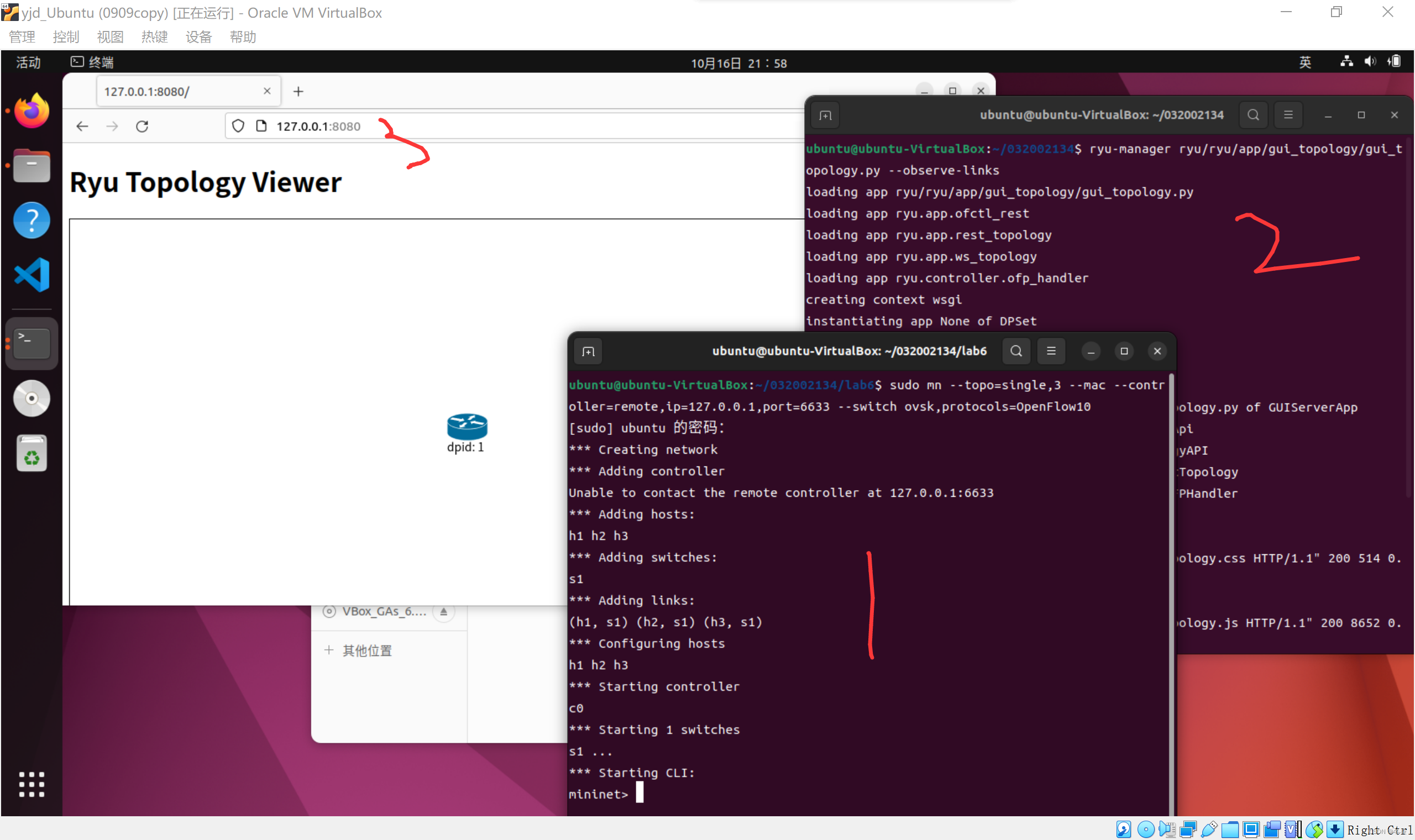
2.分析L2Switch和POX的Hub模块有何不同。
pox的Hub模块可以在运行时查看流表,而ryu的L2Switch模块无法在运行时查看到流表。不过他们也有相同点:都是依靠洪泛转发。
3.修改过的L2xxxxxxxxx.py代码和能够体现和验证修改的相关截图
代码截图:
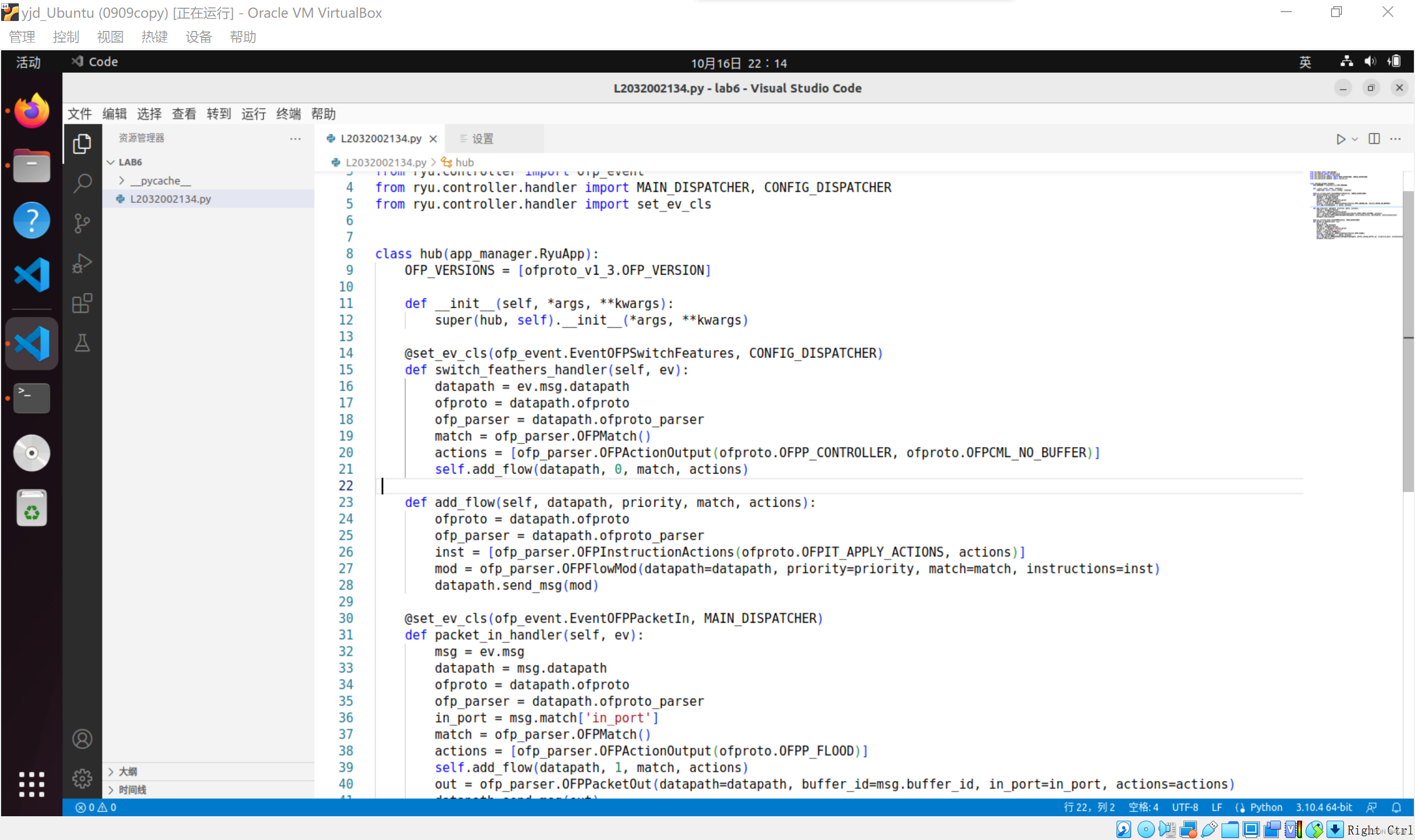
修改后运行结果:
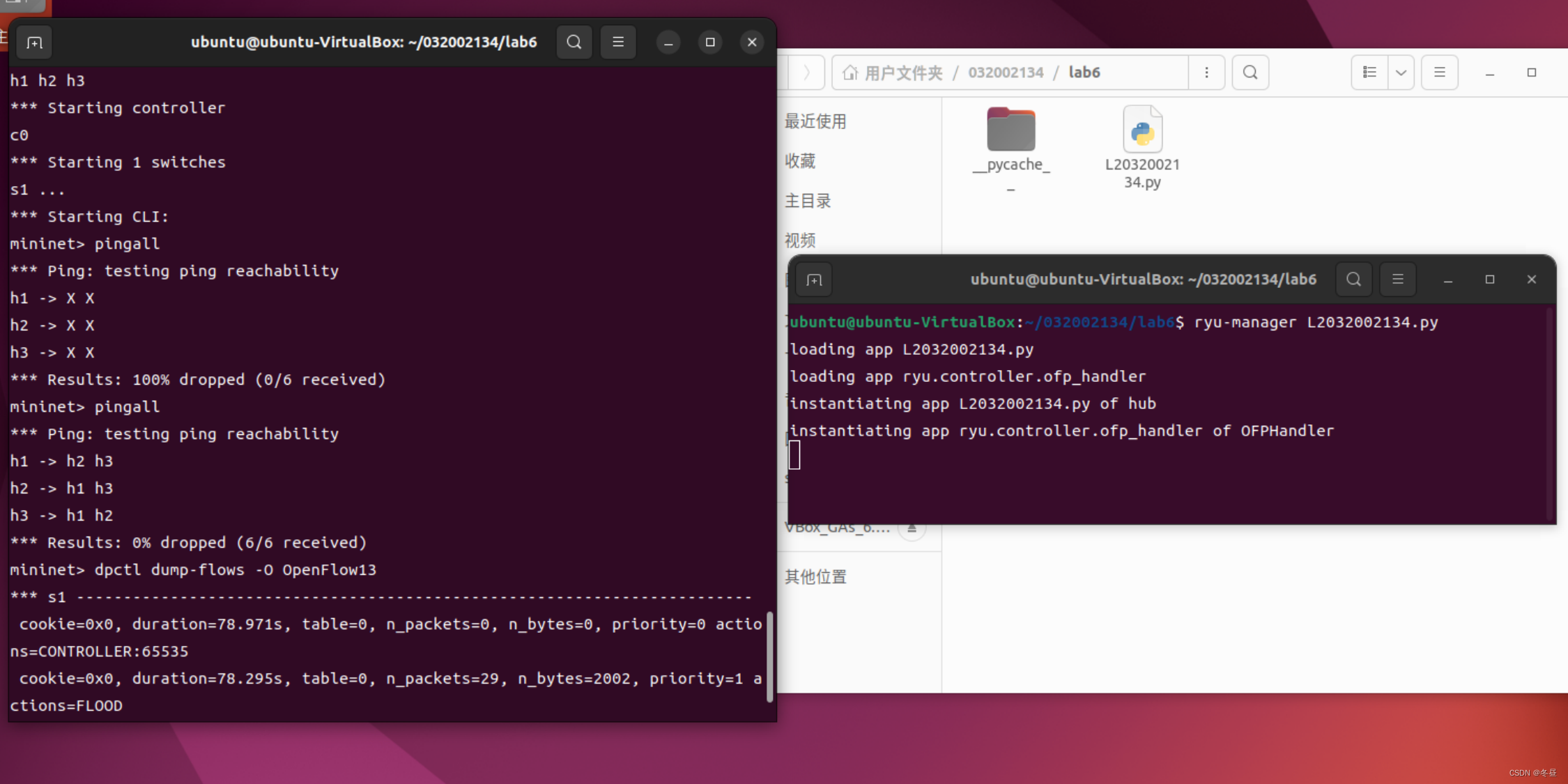
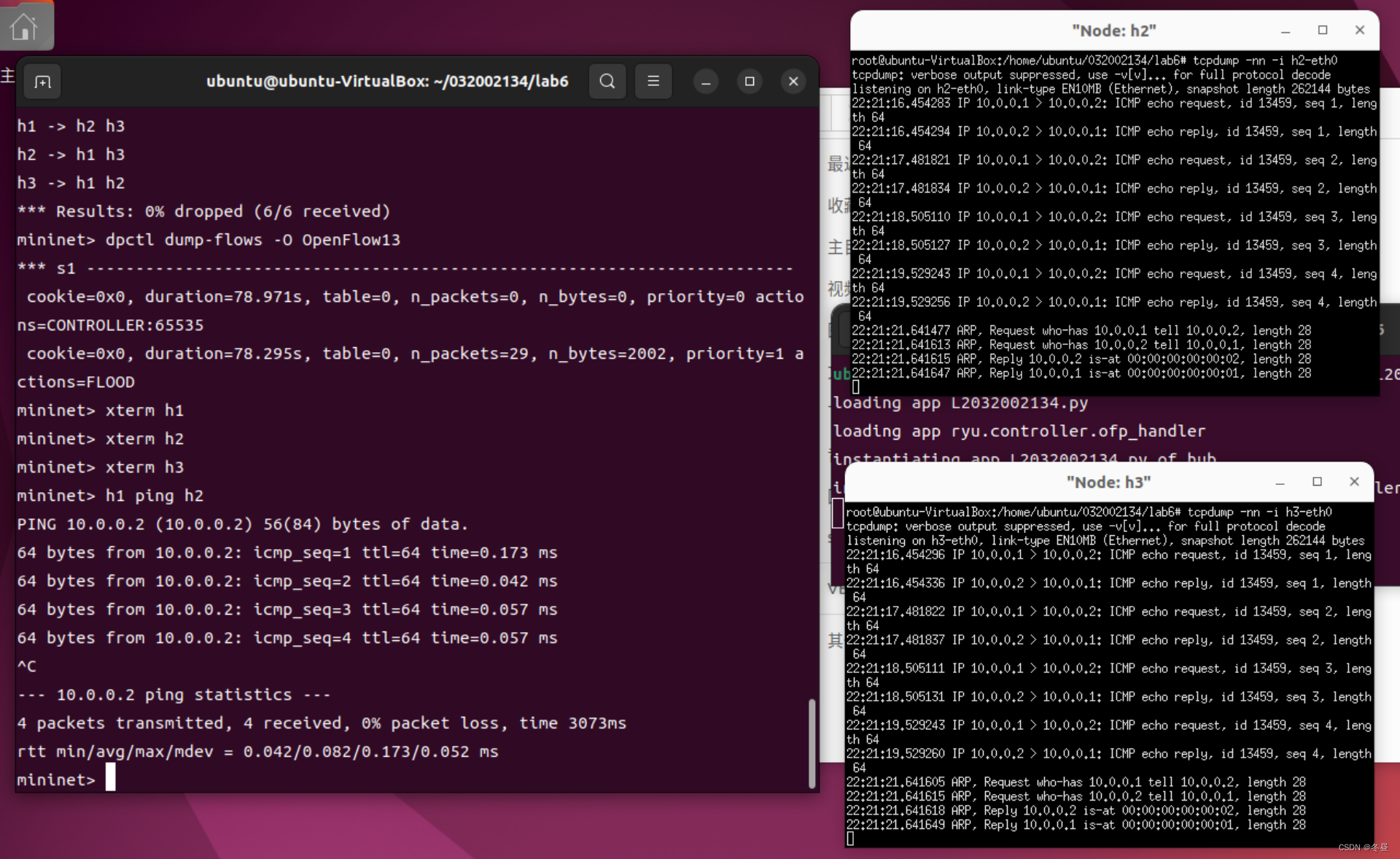
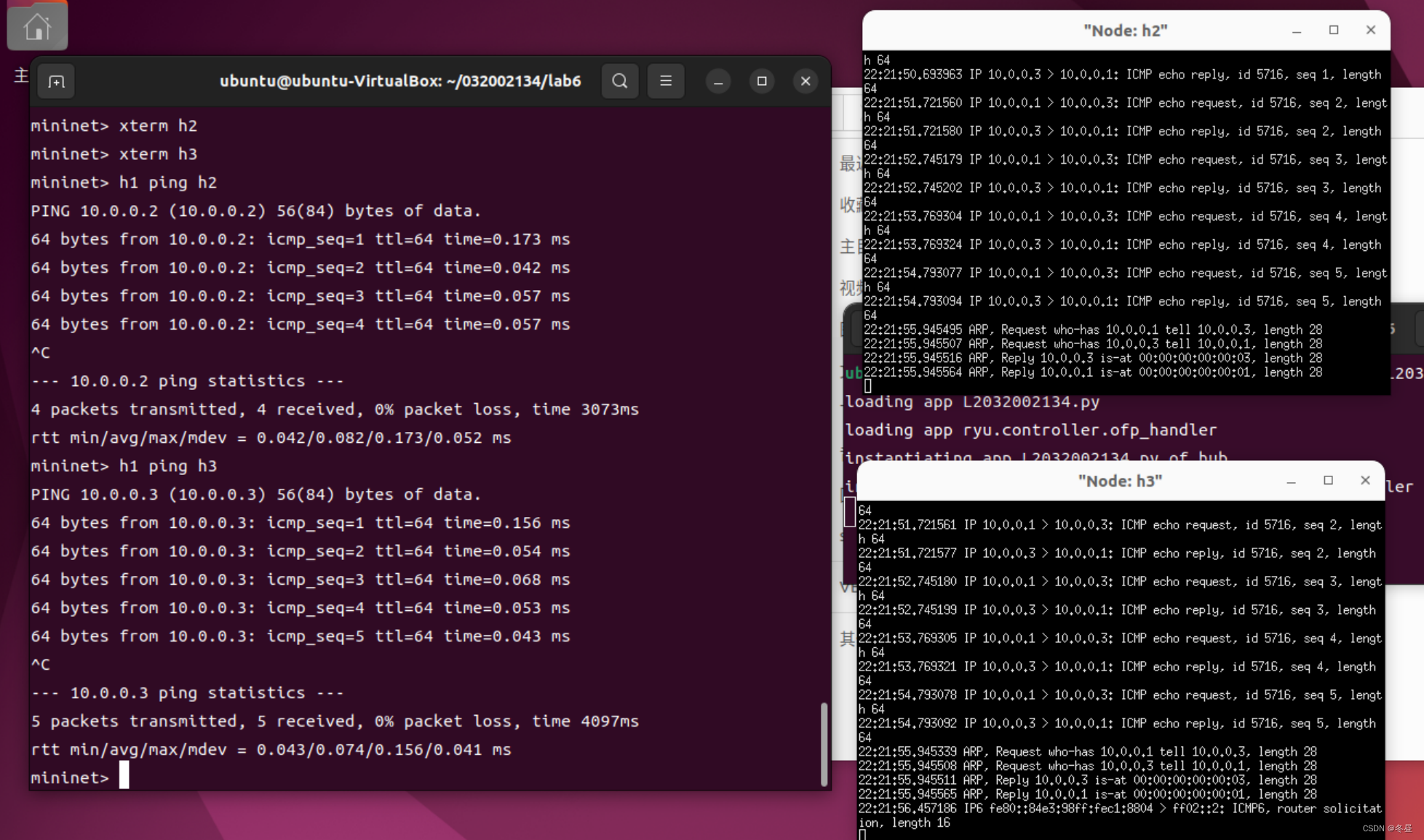
二、进阶要求
1.完成其代码的注释工作,回答下列问题:
代码注释:
# Copyright (C) 2011 Nippon Telegraph and Telephone Corporation.
#
# Licensed under the Apache License, Version 2.0 (the "License");
# you may not use this file except in compliance with the License.
# You may obtain a copy of the License at
#
# http://www.apache.org/licenses/LICENSE-2.0
#
# Unless required by applicable law or agreed to in writing, software
# distributed under the License is distributed on an "AS IS" BASIS,
# WITHOUT WARRANTIES OR CONDITIONS OF ANY KIND, either express or
# implied.
# See the License for the specific language governing permissions and
# limitations under the License.
# 引入数据包
from ryu.base import app_manager
from ryu.controller import ofp_event
from ryu.controller.handler import CONFIG_DISPATCHER, MAIN_DISPATCHER
from ryu.controller.handler import set_ev_cls
from ryu.ofproto import ofproto_v1_3
from ryu.lib.packet import packet
from ryu.lib.packet import ethernet
from ryu.lib.packet import ether_types
class SimpleSwitch13(app_manager.RyuApp):
# 定义openflow版本
OFP_VERSIONS = [ofproto_v1_3.OFP_VERSION]
def __init__(self, *args, **kwargs):
super(SimpleSwitch13, self).__init__(*args, **kwargs)
self.mac_to_port = {} # 定义保存mac地址到端口的一个映射
# 处理SwitchFeatures事件
@set_ev_cls(ofp_event.EventOFPSwitchFeatures, CONFIG_DISPATCHER)
def switch_features_handler(self, ev):
datapath = ev.msg.datapath
ofproto = datapath.ofproto
parser = datapath.ofproto_parser
# install table-miss flow entry
#
# We specify NO BUFFER to max_len of the output action due to
# OVS bug. At this moment, if we specify a lesser number, e.g.,
# 128, OVS will send Packet-In with invalid buffer_id and
# truncated packet data. In that case, we cannot output packets
# correctly. The bug has been fixed in OVS v2.1.0.
match = parser.OFPMatch() # match指流表项匹配,OFPMatch()指不匹配任何信息
actions = [parser.OFPActionOutput(ofproto.OFPP_CONTROLLER,
ofproto.OFPCML_NO_BUFFER)]
self.add_flow(datapath, 0, match, actions)
# add_flow()增加流表项
# datapath:指定的 Switch;priority:此规则的优先权;match:此规则的 Match 条件;actions:动作
def add_flow(self, datapath, priority, match, actions, buffer_id=None):
# 获取交换机信息
ofproto = datapath.ofproto
parser = datapath.ofproto_parser
# 对action进行包装
inst = [parser.OFPInstructionActions(ofproto.OFPIT_APPLY_ACTIONS,
actions)]
# 判断是否存在buffer_id,并生成mod对象
if buffer_id:
mod = parser.OFPFlowMod(datapath=datapath, buffer_id=buffer_id,
priority=priority, match=match,
instructions=inst)
else:
mod = parser.OFPFlowMod(datapath=datapath, priority=priority,
match=match, instructions=inst)
# 发送出去
datapath.send_msg(mod)
# 处理PacketIn事件
@set_ev_cls(ofp_event.EventOFPPacketIn, MAIN_DISPATCHER)
def _packet_in_handler(self, ev):
# If you hit this you might want to increase
# the "miss_send_length" of your switch
if ev.msg.msg_len < ev.msg.total_len:
self.logger.debug("packet truncated: only %s of %s bytes",
ev.msg.msg_len, ev.msg.total_len)
# 解析数据结构
msg = ev.msg
datapath = msg.datapath
# dp. ofproto 和 dp.ofproto_parser 是代表 Ryu 和交换机谈判的 OpenFlow 协议的对象
ofproto = datapath.ofproto
parser = datapath.ofproto_parser
# 获取源端口
in_port = msg.match['in_port']
pkt = packet.Packet(msg.data)
eth = pkt.get_protocols(ethernet.ethernet)[0]
if eth.ethertype == ether_types.ETH_TYPE_LLDP:
# 忽略LLDP类型的数据包
return
dst = eth.dst # 获取目的端口
src = eth.src # 获取源端口
dpid = format(datapath.id, "d").zfill(16)
self.mac_to_port.setdefault(dpid, {})
self.logger.info("packet in %s %s %s %s", dpid, src, dst, in_port)
# 学习包的源地址,和交换机上的入端口绑定
self.mac_to_port[dpid][src] = in_port
# 查看是否已经学习过该目的mac地址
# 如果目的地址存在于mac_to_port中
if dst in self.mac_to_port[dpid]:
out_port = self.mac_to_port[dpid][dst]
# 如果没有学习过该目的mac地址
else:
# OFPP_FLOOD标志表示应在所有端口发送数据包,即洪泛
out_port = ofproto.OFPP_FLOOD
actions = [parser.OFPActionOutput(out_port)]
# 下发流表避免下次触发 packet in 事件
if out_port != ofproto.OFPP_FLOOD:
match = parser.OFPMatch(in_port=in_port, eth_dst=dst, eth_src=src)
# 验证我们是否有一个有效的buffer_id,如果是避免发送两个
if msg.buffer_id != ofproto.OFP_NO_BUFFER:
self.add_flow(datapath, 1, match, actions, msg.buffer_id)
return
else:
self.add_flow(datapath, 1, match, actions)
data = None
if msg.buffer_id == ofproto.OFP_NO_BUFFER:
data = msg.data
# 发送Packet_out数据包
out = parser.OFPPacketOut(datapath=datapath, buffer_id=msg.buffer_id,
in_port=in_port, actions=actions, data=data)
# 发送流表
datapath.send_msg(out)
a) 代码当中的mac_to_port的作用是什么?
保存mac地址到交换机端口的映射
b) simple_switch和simple_switch_13在dpid的输出上有何不同?
simple_switch_13会用0在dpid前填充至总长度为16,而simple_switch直接输出dpid。
这可以从以下代码看出。
dpid = format(datapath.id, "d").zfill(16)
self.mac_to_port.setdefault(dpid, {})
dpid = datapath.id
self.mac_to_port.setdefault(dpid, {})
c) 相比simple_switch,simple_switch_13增加的switch_feature_handler实现了什么功能?
simple_switch_13交换机可以以特性应答消息来响应特性请求
d) simple_switch_13是如何实现流规则下发的?
- 在触发packetIn事件后,解析相关数据结构,获取协议信息、获取源端口、包学习,交换机信息,以太网信息等多种信息。
- 如果以太网类型是LLDP类型,则忽略。
- 如果不是LLDP类型,则获取目的端口和源端口以及交换机id,
- 然后进行交换机自学习,先学习源地址对应的交换机的入端口,
- 再查看是否已经学习目的mac地址,如果没有就进行洪泛转发。如果学习过,查看是否有buffer_id,如果有则在添加流时加上buffer_id,向交换机发送数据包和流表。
e) switch_features_handler和_packet_in_handler两个事件在发送流规则的优先级上有何不同?
switch_features_handler的优先级更高
2.编程实现和ODL实验的一样的硬超时功能
代码:
from ryu.base import app_manager
from ryu.controller import ofp_event
from ryu.controller.handler import CONFIG_DISPATCHER, MAIN_DISPATCHER
from ryu.controller.handler import set_ev_cls
from ryu.ofproto import ofproto_v1_3
from ryu.lib.packet import packet
from ryu.lib.packet import ethernet
from ryu.lib.packet import ether_types
class SimpleSwitch13(app_manager.RyuApp):
OFP_VERSIONS = [ofproto_v1_3.OFP_VERSION]
def __init__(self, *args, **kwargs):
super(SimpleSwitch13, self).__init__(*args, **kwargs)
self.mac_to_port = {}
@set_ev_cls(ofp_event.EventOFPSwitchFeatures, CONFIG_DISPATCHER)
def switch_features_handler(self, ev):
datapath = ev.msg.datapath
ofproto = datapath.ofproto
parser = datapath.ofproto_parser
match = parser.OFPMatch()
actions = [parser.OFPActionOutput(ofproto.OFPP_CONTROLLER,
ofproto.OFPCML_NO_BUFFER)]
self.add_flow(datapath, 0, match, actions)
def add_flow(self, datapath, priority, match, actions, buffer_id=None, hard_timeout=0):
ofproto = datapath.ofproto
parser = datapath.ofproto_parser
inst = [parser.OFPInstructionActions(ofproto.OFPIT_APPLY_ACTIONS,
actions)]
if buffer_id:
mod = parser.OFPFlowMod(datapath=datapath, buffer_id=buffer_id,
priority=priority, match=match,
instructions=inst, hard_timeout=hard_timeout)
else:
mod = parser.OFPFlowMod(datapath=datapath, priority=priority,
match=match, instructions=inst, hard_timeout=hard_timeout)
datapath.send_msg(mod)
@set_ev_cls(ofp_event.EventOFPPacketIn, MAIN_DISPATCHER)
def _packet_in_handler(self, ev):
# If you hit this you might want to increase
# the "miss_send_length" of your switch
if ev.msg.msg_len < ev.msg.total_len:
self.logger.debug("packet truncated: only %s of %s bytes",
ev.msg.msg_len, ev.msg.total_len)
msg = ev.msg
datapath = msg.datapath
ofproto = datapath.ofproto
parser = datapath.ofproto_parser
in_port = msg.match['in_port']
pkt = packet.Packet(msg.data)
eth = pkt.get_protocols(ethernet.ethernet)[0]
if eth.ethertype == ether_types.ETH_TYPE_LLDP:
# ignore lldp packet
return
dst = eth.dst
src = eth.src
dpid = format(datapath.id, "d").zfill(16)
self.mac_to_port.setdefault(dpid, {})
self.logger.info("packet in %s %s %s %s", dpid, src, dst, in_port)
# learn a mac address to avoid FLOOD next time.
self.mac_to_port[dpid][src] = in_port
if dst in self.mac_to_port[dpid]:
out_port = self.mac_to_port[dpid][dst]
else:
out_port = ofproto.OFPP_FLOOD
actions = [parser.OFPActionOutput(out_port)]\
actions_timeout=[]
# install a flow to avoid packet_in next time
if out_port != ofproto.OFPP_FLOOD:
match = parser.OFPMatch(in_port=in_port, eth_dst=dst, eth_src=src)
# verify if we have a valid buffer_id, if yes avoid to send both
# flow_mod & packet_out
hard_timeout=10
if msg.buffer_id != ofproto.OFP_NO_BUFFER:
self.add_flow(datapath, 2, match,actions_timeout, msg.buffer_id,hard_timeout=10)
self.add_flow(datapath, 1, match, actions, msg.buffer_id)
return
else:
self.add_flow(datapath, 2, match, actions_timeout, hard_timeout=10)
self.add_flow(datapath, 1, match, actions)
data = None
if msg.buffer_id == ofproto.OFP_NO_BUFFER:
data = msg.data
out = parser.OFPPacketOut(datapath=datapath, buffer_id=msg.buffer_id,
in_port=in_port, actions=actions, data=data)
datapath.send_msg(out)
硬超时效果:
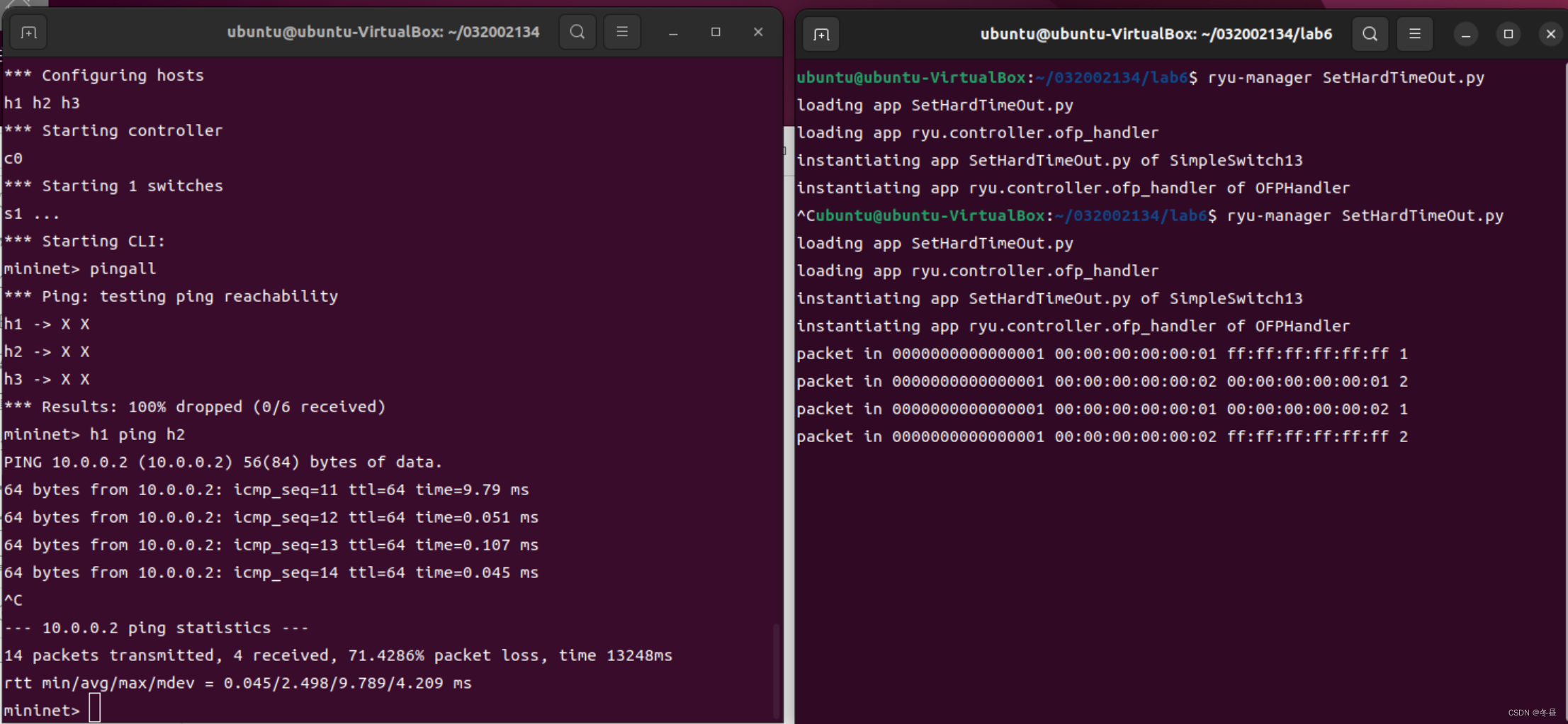

三、个人总结
- 本次实验难度偏难。
- 首先是一开始连ryu manager都运行不了,遇到cannot set 'is_timeout' attribute of immutable type 'TimeoutError'的错误。经过不断地网上搜索和调试,摸索出解决方案为先pip install eventlet,此时还是会报错,不过报错会变为AttributeError: module 'collections' has no attribute 'MutableMapping',此时只需要将
namedict.py文件中的collections.MutableMapping改成collections.abc.MutableMapping即可解决报错,成功运行ryu控制器。 - 然后是查看流表时报错s1.mgmt: version negotiation failed (we support version 0x01, peer supports version 0x04) ovs-ofctl: s1: failed to connect to socket (Broken pipe),最后是在老师的博客中找到了解决的方法。
- 本次实验学习了一下ryu控制器,也体会了一下ryu和pox的区别,但对ryu的理解感觉还不是很全面,仍需要加强学习。看英文文档挺痛苦的,不管是之前的ryu还是pox,也算是初步体会到了英语的重要性。机翻总有一些翻译得奇奇怪怪的地方,还是要加强英语文献阅读能力。

